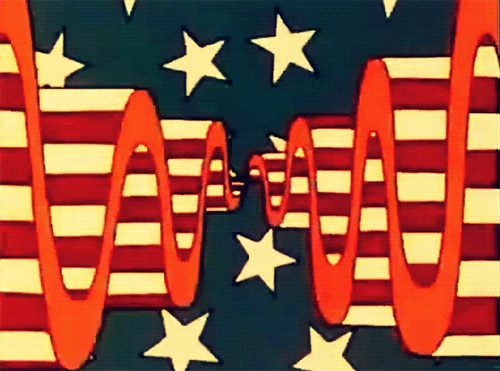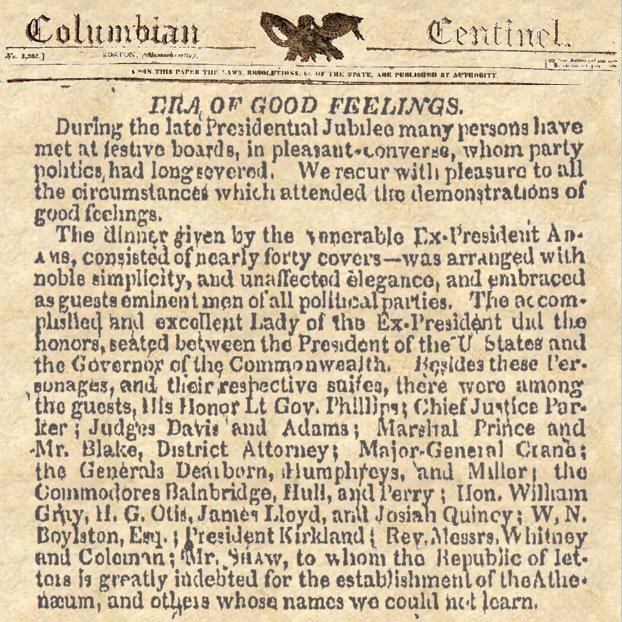Independence Day Celebration in Centre Square by John Lewis Krimmel (1787–1821)
The Brief Period, 200 Years Ago, When American Politics Was Full of “Good Feelings”
James Monroe’s 1817 goodwill tour kicked off a decade of party-less government – but he couldn’t stop the nation from dividing again
James Monroe rode into Boston Common astride a borrowed horse, wearing a blue coat, knee-buckled breeches, and a Revolutionary triangular hat. A cheering crowd of 40,000 people greeted him.
But it wasn’t the 1770s, and the founding father was no longer young. It was July 1817, and the new nation was 41 years old. The clothing worn by the nation’s fifth president was now out of fashion. He wasn’t in Boston to drum up support for a new nation—he was there to keep it from falling apart.
Monroe, a Democratic-Republican, had won a landslide victory against the collapsing Federalist Party in the 1816 election. Now, he was touring the nation, ostensibly to visit military installations, but also in hopes of stirring up a patriotic outpouring that would bring about the end of political parties in the United States.
He wanted to heal the wounds of the War of 1812, hurry along with the Federalist collapse, and bring about the party-less government George Washington had envisioned in his farewell address. And he succeeded, for a while. Monroe’s presidency marks the last time the United States didn’t have a two-party system.
Monroe swept into the presidency as an American war hero and a symbol of the young nation’s history. He’d joined the Continental Army in 1776, was wounded at the Battle of Trenton, and survived the brutal winter of 1778 at Valley Forge. He was elected to the Virginia legislature, the Continental Congress, and the U.S. Senate. He served twice as an American diplomat in France and was governor of Virginia. In 1811, President James Madison named him secretary of state.
During the War of 1812, Monroe stepped up to rally the nation he’d helped form. In August 1814, the British captured Washington, D.C., and burned nearly all its public buildings, including the White House. Returning to the wrecked capital after a British retreat, the overwhelmed Madison, whose cerebral temperament left him ill-prepared to lead in wartime, handed Monroe a second title: acting secretary of war. He took charge of the war effort, reinforcing Washington and Baltimore, ordering Andrew Jackson to defend New Orleans, and convincing state governors to send more militiamen to the battle zones.
By the war’s end, the partisan conflict that had defined American politics for two decades was sputtering out. Thomas Jefferson’s Democratic-Republicans, who believed in limited powers for the federal government, had held the presidency for 16 years since Jefferson’s 1800 defeat of Federalist John Adams. But the war had scrambled the parties’ old roles. Federalists in New England had largely opposed the War of 1812. Many gathered at the secret Hartford Convention of 1814-15, where the most radical delegates called for New England to secede from the Union. Instead, the convention voted to send negotiators to Washington to demand changes in the Constitution, including limits on the president’s power to make war. But news of the war’s end reached Washington before the Federalist delegates did, leaving them looking like near-traitors who had schemed in secrecy.
Monroe won the 1816 election in a landslide and developed a plan to, in his words, “prevent the re-organization and revival of the federal party” and “exterminate all party divisions in our country.” His motives were mixed. Like Washington, he believed that political parties were unnecessary to good government, but he was also furious at the wartime Federalist secessionist movement. He froze out the Federalists, gave them no patronage, and didn’t even acknowledge them as members of a party. But publicly, Monroe made no partisan comments, instead of appealing to all Americans on the basis of patriotism. “Discord does not belong to our system,” he declared in his inaugural address. “Harmony among Americans… will be the object of my constant and zealous attentions.”
Emulating Washington’s tours of the nation as president, Monroe set out on his first goodwill tour on June 1, 1817. He spent all summer touring the nation, traveling by steamboat and carriage, and on horseback. Like politicians today, he shook hands with aging veterans and kissed little kids. He toured farms, hobnobbed with welcoming committees, and patiently endured endless speeches by local judges.
Boston was the biggest test of Monroe’s goodwill. Massachusetts was the nation’s citadel of Federalism, and it had voted for Monroe’s opponent, Rufus King, in 1816. But Boston seized the chance for reconciliation, greeting Monroe with boys clothed in mini-versions of Revolutionary attire and 2,000 girls in white dresses, decorated with either white or red roses, to symbolize the reconciliation of the Federalists and Democratic-Republicans.
The night of his victorious appearance on Boston Common, Monroe attended a dinner hosted by Massachusetts Governor John Brooks. To his surprise, other guests included John Adams, the Federalist ex-president, and Timothy Pickering, the former Federalist secretary of state who had recalled Monroe from his diplomatic post in Paris in 1796. “People now meet in the same room who would before scarcely pass the same street,” marveled Boston’s Chronicle and Patriot newspaper.
Boston swooned. On July 12, the Columbian Centinel, an ardent Federalist newspaper, published a headline, “Era of Good Feelings,” that would define Monroe’s presidency. “During the late Presidential Jubilee,” the story began, “many persons have met at festive boards, in pleasant converse, whom party politics had long severed.”
Returning to Washington in September 1817, Monroe extended the good feelings into national policy. He convinced Congress to abolish all of the federal government’s internal taxes in the U.S., including property taxes—confident that customs tariffs and the sale of public land could fund the federal government. Yet he still paid off the nation’s $67 million war debt within two years. (Tariffs continued to pay for the federal government’s budget until the Civil War when the federal government founded its department of internal revenue.) He supported Andrew Jackson’s 1819 invasion of Florida, then had John Quincy Adams negotiate a treaty with Spain that ceded Florida to the U.S. The Monroe administration built up the nation’s defenses and strengthened West Point into an elite military academy. Pioneers flooded westward. In his 1823 message to Congress, he articulated what came to be known as the Monroe Doctrine, warning European powers that any future attempt to colonize the Western Hemisphere would be considered a threat to the United States.
Even the great regional battles over extending slavery westward didn’t scuttle Monroe’s efforts to create a new political era. In March 1820, three weeks after signing the Missouri Compromise, Monroe set out on a four-month, 5,000-mile tour of the South, where his success at getting the Spanish out of Florida was wildly popular. Charleston and Savannah, especially, celebrated Monroe with such zeal that a Georgia newspaper declared Savannah was “in danger of overdoing it.” Monroe visited Jackson at his Tennessee home, The Hermitage, and spoke at the Nashville Female Academy, the country’s largest school for women, before swinging back to Washington in August.
Of course, the “Good Feelings” nickname only applied to those who could enjoy the rights enshrined in the Constitution. Native Americans, enslaved persons, and other besieged groups would have had little “good” to say about the era. Nor would the huge number of Americans impoverished in the Panic of 1819.
Still, as Monroe had hoped, the Federalist Party died away. “A few old Federalists still moved around the capital, like statues or mummies,” wrote George Dangerfield in his 1952 book The Era of Good Feelings, but “all ambitious men called themselves Republicans, or sought, without undergoing a public conversion, to attach themselves to whatever Republican faction would best serve their interests.”
In 1820, Monroe won a second term essentially unopposed, with an Electoral College vote of 231 to 1. He felt he had carried out “the destruction of the federal party,” he wrote to Madison in 1822. “Our government may get on and prosper without the existence of parties.”
But the good feelings didn’t last. The U.S. forsook parties, but it couldn’t forsake politics.
Though historians disagree on when the era closed – some say it only lasted two years, ending with the Panic of 1819 -- ill feelings defined America’s mood by the end of Monroe’s second term. Without party discipline, governing got harder. By the early 1820s, it was every man for himself in Congress and even in Monroe’s cabinet: Secretary of State Adams, Treasury Secretary William H. Crawford, and Secretary of War John C. Calhoun all jockeyed to succeed Monroe as president.
The incident that best proves the Era of Good Feelings over occurred in winter 1824. Crawford, furious at Monroe for not protecting his cronies during Army budget cuts, confronted him at the White House. “You infernal scoundrel,” the treasury secretary hissed, raising his cane at the president. Monroe grabbed fireplace tongs to defend himself, Navy Secretary Samuel L. Southard stepped between the men, and Crawford apologized and left the White House, never to return.
The 1824 presidential election, held without parties, attracted four candidates: Jackson, Adams, Crawford, and House Speaker Henry Clay. After none won an Electoral College majority, the House of Representatives elected Adams, the second-place finisher, as president – passing over Jackson, who’d won the most electoral votes and popular votes. That election provoked American politics to reorganize into a new two-party system—Jacksonian Democrats versus Adams’ Whigs.
Monroe died on July 4, 1831, with a substantial legacy in American history, from the Monroe Doctrine’s influence on foreign policy to his role in the nation’s westward expansion. But the nation never again neared his ideal of a party-free government. For better and for worse, through battles over economics and war, slavery, and immigration, the two-party system he inadvertently spawned has defined American politics ever since.


Those Who Don't Know The True Value Of Loyalty Can Never Appreciate The Cost Of Betrayal.
GUEST POSTING: WOULD YOU LIKE TO BE PUBLISHED ... DO YOU HAVE SOMETHING ON YOUR MIND?
Knowledge Is Power - Information Is Liberating: The LIBERTY TREE & FRIENDS is a non-profit blog dedicated to bringing as much truth as possible to the readers.
Big Tech has greatly reduced the distribution of our stories in our readers' newsfeeds and is instead promoting mainstream media sources. When you share with your friends, however, you greatly help distribute our content. Please take a moment and consider sharing this article with your friends and family. Thank you
Please share… Like many other fact-oriented bloggers, we've been exiled from Facebook as well as other "mainstream" social sites.
We will continue to search for alternative sites, some of which have already been compromised, in order to deliver our message and urge all of those who want facts, not spin and/or censorship, to do so as well.
Keep on seeking the truth, rally your friends and family and expose as much corruption as you can… every little bit helps add pressure on the powers that are no more.

/https://public-media.si-cdn.com/filer/68/87/68874c05-8488-4650-84f8-0c64b2d11b69/independence_day_celebration_in_centre_square.jpg)



No comments:
Post a Comment